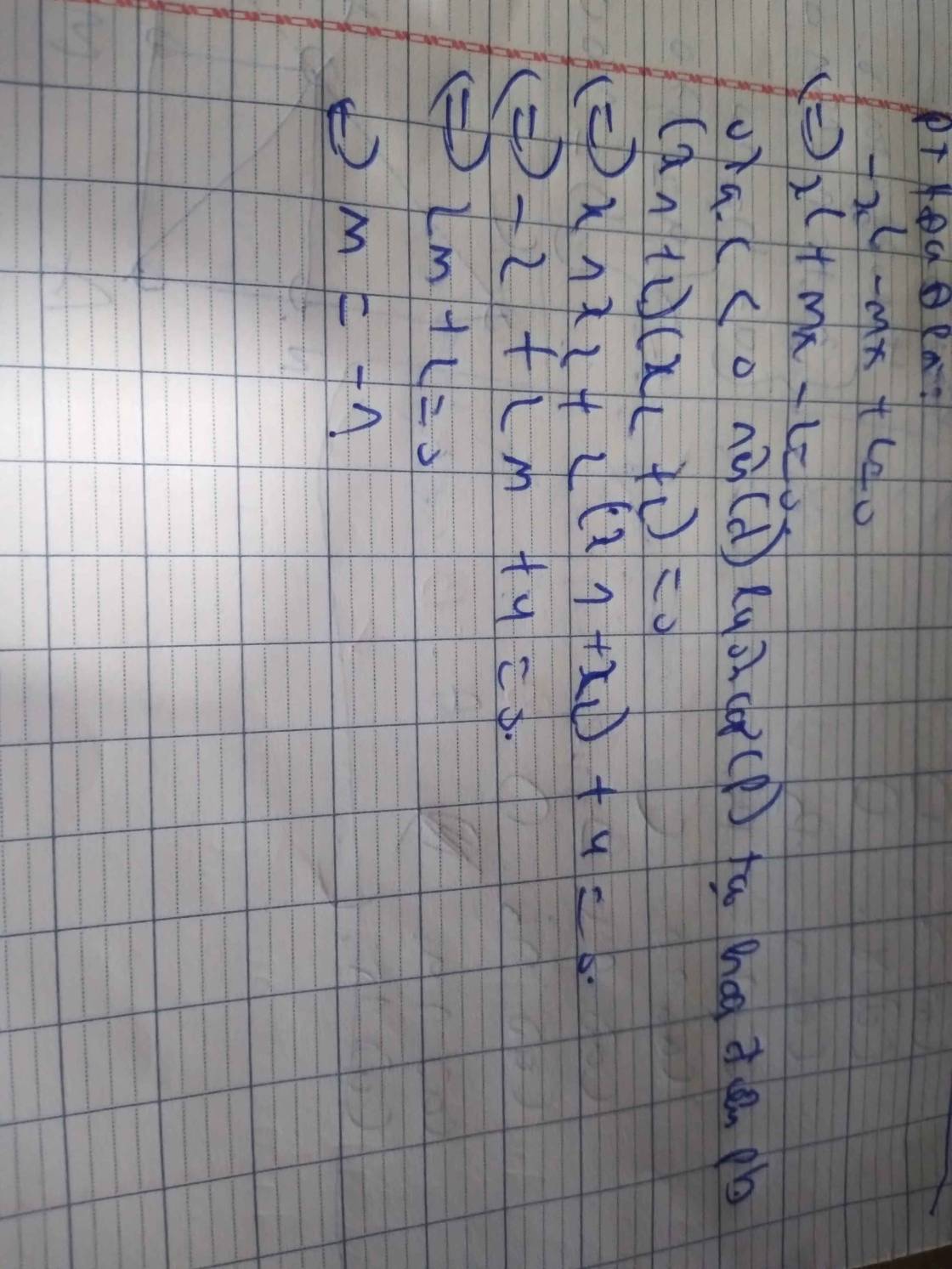Hãy nhập câu hỏi của bạn vào đây, nếu là tài khoản VIP, bạn sẽ được ưu tiên trả lời.

a) Xét phương trình hoành độ giao điểm chung của (d) và (P) :
\(x^2=\left(2m-1\right)x-m^2+2\)
\(\Leftrightarrow x^2-\left(2m-1\right)x+m^2-2=0\left(1\right)\)
Thay m=2 vào pt (1) ta được:
\(x^2-3x+2=0\)
\(\Leftrightarrow\orbr{\begin{cases}x=1\Rightarrow y=1\\x=2\Rightarrow y=4\end{cases}}\)
Tọa độ giao điểm của (d) và (P) khi m=2 là \(A\left(1;1\right);B\left(2;4\right)\)
b) \(\Delta_{\left(1\right)}=\left(2m-1\right)^2-4m^2+8\)
\(=4m^2-4m+1-4m^2+8\)
\(=9-4m\)
Để pt (1) có 2 n ghiệm pb \(\Leftrightarrow9-4m>0\Leftrightarrow m< \frac{9}{4}\)
Theo hệ thức Vi-et ta có:
\(\hept{\begin{cases}x_1+x_2=2m-1\\x_1.x_2=m^2-2\left(1\right)\end{cases}}\)
Ta có: \(\hept{\begin{cases}x_1+x_2=2m-1\\x_1-3x_2=7\end{cases}}\)
\(\Leftrightarrow\hept{\begin{cases}3x_1+3x_2=6m-3\\x_1-3x_2=7\end{cases}}\)
\(\Leftrightarrow\hept{\begin{cases}x_1=\frac{3m+2}{2}\\x_2=\frac{m-4}{2}\end{cases}\left(3\right)}\)
Thay (3) vào (2) ta được:
\(\frac{3m+2}{2}.\frac{m-4}{2}=m^2-2\)
\(\Leftrightarrow\frac{3m^2-10m-8}{4}=m^2-2\)
\(\Rightarrow3m^2-10m-8=4m^2-8\)
\(\Leftrightarrow m^2+10m=0\)
\(\Leftrightarrow\orbr{\begin{cases}m=0\\m=-10\end{cases}\left(tm\right)}\)
Vậy ...

1) ĐK \(\hept{\begin{cases}x\ne y\\y\ge-1\end{cases}}\)
Đặt \(\hept{\begin{cases}\frac{1}{x-y}=a\left(a\ne0\right)\\\sqrt{y+1}=b\left(b\ge0\right)\end{cases}}\)hệ phương trình đã cho trở thành
\(\hept{\begin{cases}2a+b=4\\a-3b=-5\end{cases}}\Leftrightarrow\hept{\begin{cases}2a+b=4\\2a-6b=-10\end{cases}}\Leftrightarrow\hept{\begin{cases}7b=14\\2a+b=4\end{cases}}\Leftrightarrow\hept{\begin{cases}a=1\\b=2\end{cases}\left(tm\right)}\)
\(\Rightarrow\hept{\begin{cases}\frac{1}{x-y}=1\\\sqrt{y+1}=2\end{cases}}\Leftrightarrow\hept{\begin{cases}x-y=1\\y+1=4\end{cases}}\Leftrightarrow\hept{\begin{cases}x=4\\y=3\end{cases}}\left(tm\right)\)
Vậy ...

1) ĐK \(\hept{\begin{cases}x\ge0\\y\ne1\end{cases}}\)
Đặt \(\hept{\begin{cases}2\sqrt{x}=a\left(a\ge0\right)\\\frac{1}{y-1}=b\left(b\ne0\right)\end{cases}}\)hệ phương trình đã cho trở thành
\(\hept{\begin{cases}a+3b=5\\2a-b=3\end{cases}}\Leftrightarrow\hept{\begin{cases}2a+6b=10\\2a-b=3\end{cases}}\Leftrightarrow\hept{\begin{cases}7b=7\\2a-b=3\end{cases}}\Leftrightarrow\hept{\begin{cases}a=2\\b=1\end{cases}\left(tm\right)}\)
\(\Rightarrow\hept{\begin{cases}2\sqrt{x}=2\\\frac{1}{y-1}=1\end{cases}}\Rightarrow\hept{\begin{cases}x=1\\y=2\end{cases}}\left(tm\right)\)
Vậy ...
1,\(\left\{{}\begin{matrix}2\sqrt{x}+\dfrac{3}{y-1}=5\\4\sqrt{x}-\dfrac{1}{y-1}=3\end{matrix}\right.\) ĐKXĐ:x≥o,y≠1
⇔\(\left\{{}\begin{matrix}4\sqrt{x}+\dfrac{6}{y-1}=10\\4\sqrt{x}-\dfrac{1}{y-1}=3\end{matrix}\right.\Leftrightarrow\left\{{}\begin{matrix}\dfrac{7}{y-1}=7\\4\sqrt{x}-\dfrac{1}{y-1}=3\end{matrix}\right.\)\(\Leftrightarrow\left\{{}\begin{matrix}y-1=1\\4\sqrt{x}-\dfrac{1}{y-1}=3\end{matrix}\right.\Leftrightarrow\left\{{}\begin{matrix}y-1=1\\4\sqrt{x}-\dfrac{1}{1}=3\end{matrix}\right.\Leftrightarrow\left\{{}\begin{matrix}y=2\\4\sqrt{x}=4\end{matrix}\right.\Leftrightarrow\left\{{}\begin{matrix}y=2\\\sqrt{x}=1\end{matrix}\right.\Leftrightarrow\left\{{}\begin{matrix}y=2\\x=1\end{matrix}\right.\left(TM\right)\)
vậy hpt đã cho có nghiệm duy nhất (x,y)=(1,2)
2,a, xét pthđgđ của (d) và (p) khi m=3:
x\(^2\)=3x-1⇔\(x^2-3x+1=0\)
Δ=(-3)\(^2\)-4.1.1=5>0
⇒pt có 2 nghiệm pb
\(x_1=\dfrac{3+\sqrt{5}}{2}\) ,\(x_2=\dfrac{3-\sqrt{5}}{2}\)
thay x=x\(_1\)=\(\dfrac{3+\sqrt{5}}{2}\) vào hs y=x\(^2\) ta được:
y=(\(\dfrac{3+\sqrt{5}}{2}\))\(^2\)=\(\dfrac{14+6\sqrt{5}}{4}\)⇒A(\(\dfrac{3+\sqrt{5}}{2},\dfrac{14+6\sqrt{5}}{4}\))
thay x=x\(_2\)=\(\dfrac{3-\sqrt{5}}{2}\) vào hs y=x\(^2\) ta được:
y=\(\left(\dfrac{3-\sqrt{5}}{2}\right)^2=\dfrac{14-6\sqrt{5}}{4}\)⇒B(\(\dfrac{3-\sqrt{5}}{2},\dfrac{14-6\sqrt{5}}{4}\))
vậy tọa độ gđ của (d) và (p) là A(\(\dfrac{3+\sqrt{5}}{2},\dfrac{14+6\sqrt{5}}{4}\)) và B (\(\dfrac{3-\sqrt{5}}{2},\dfrac{14-6\sqrt{5}}{4}\))
b,xét pthđgđ của (d) và (p) :
\(x^2=mx-1\)⇔\(x^2-mx+1=0\) (*)
Δ=(-m)\(^2\)-4.1.1=m\(^2\)-4
⇒pt có hai nghiệm pb⇔Δ>0
⇔m\(^2\)-4>0⇔m>16
với m>16 thì pt (*) luôn có hai nghiệm pb \(x_1,x_2\)
theo hệ thức Vi-ét ta có:
(I) \(\left\{{}\begin{matrix}x_1+x_2=m\\x_1.x_2=1\end{matrix}\right.\)
\(x_1,x_2\) TM \(x_2\)(x\(_1\)\(^2\)+1)=3
⇒\(x_2.x_1^2\)+\(x_2\)=3⇔\(x_2.x_1.x_1+x_2=3\)⇔(\(x_2.x_1\))(\(x_1+x_2\))=3 (**)
thay (I) vào (**) ta được:
1.m=3⇔m=3 (TM m≠0)
vậy m=3 thì (d) cắt (p) tại hai điểm pb có hoanh độ \(x_1.x_2\) TM \(x_2\)(\(x_1^2+1\))=3

a: Phương trình hoành độ giao điểm là:
x^2-mx-4=0
a*c<0
=>(d) luôn cắt (P) tại hai điểm phân biệt
c: x1^2+mx2=6m-5
=>x1^2+x2(x1+x2)=6m-5
=>(x1+x2)^2-x1x2=6m-5
=>m^2-(-4)-6m+5=0
=>m^2-6m+9=0
=>m=3

`a)` H/s nghịch biến trên `RR`. Vì `a=-2 < 0`
`b)` Ptr hoành độ của `(d)` và `(P)` là:
`-2x+m=x^2`
`<=>x^2+2x-m=0` `(1)`
`(d)` cắt `(P)` tại `2` điểm có hoành độ phân biệt `<=>` Ptr `(1)` có `2` nghiệm phân biệt
`=>\Delta' > 0`
`<=>1+m > 0<=>m > -1`
`=>` Áp dụng Viét có: `{(x_1+x_2=-b/a=-2),(x_1.x_2=c/a=-m):}`
Ta có: `|x_1-x_2|=4`
`<=>\sqrt{(x_1-x_2)^2}=4`
`<=>\sqrt{(x_1+x_2)^2-4x_1.x_2}=4`
`<=>(-2)^2-4.(-m)=16`
`<=>m=3` (t/m)

a,bạn thay m = 2 vào (d), lập hoành độ tự tìm nhé
Hoành độ giao điểm (P) ; (d) tm pt
\(x^2-mx-3=0\)
\(\Delta=m^2-4\left(-3\right)=m^2+12>0\)
Vậy pt luôn có 2 nghiệm pb
Theo Vi et \(\left\{{}\begin{matrix}x_1+x_2=m\\x_1x_2=-3\end{matrix}\right.\)
Ta có \(\dfrac{x_1+x_2}{x_1x_2}=\dfrac{3}{2}\)Thay vào ta được
\(\dfrac{m}{-3}=\dfrac{3}{2}\Leftrightarrow m=-\dfrac{9}{2}\)

a) Khi m = 2 thì: \(\hept{\begin{cases}y=x^2\\y=2x+3\end{cases}}\)
Hoành độ giao điểm (P) và (d) là nghiệm của PT: \(x^2=2x+3\Leftrightarrow x^2-2x-3=0\Leftrightarrow\left(x+1\right)\left(x-3\right)=0\)
\(\Leftrightarrow\orbr{\begin{cases}x+1=0\\x-3=0\end{cases}}\Leftrightarrow\orbr{\begin{cases}x=-1\Rightarrow y=1\\x=3\Rightarrow y=9\end{cases}}\)
Vậy tọa độ giao điểm của (P) và (d) là \(\left(-1;1\right)\) và \(\left(3;9\right)\)
b) Hoành độ giao điểm của (P) và (d) là nghiệm của PT:
\(x^2=mx+3\Leftrightarrow x^2-mx-3=0\)
Vì \(ac=1\cdot\left(-3\right)< 0\) => PT luôn có 2 nghiệm phân biệt
Theo hệ thức viet ta có: \(\hept{\begin{cases}x_1+x_2=m\\x_1x_2=-3\end{cases}}\)
Mà \(\frac{1}{x_1}+\frac{1}{x_2}=\frac{3}{2}\Leftrightarrow\frac{x_1+x_2}{x_1x_2}=\frac{3}{2}\Leftrightarrow\frac{-m}{3}=\frac{3}{2}\Rightarrow m=-\frac{9}{2}\)
Vậy \(m=-\frac{9}{2}\)